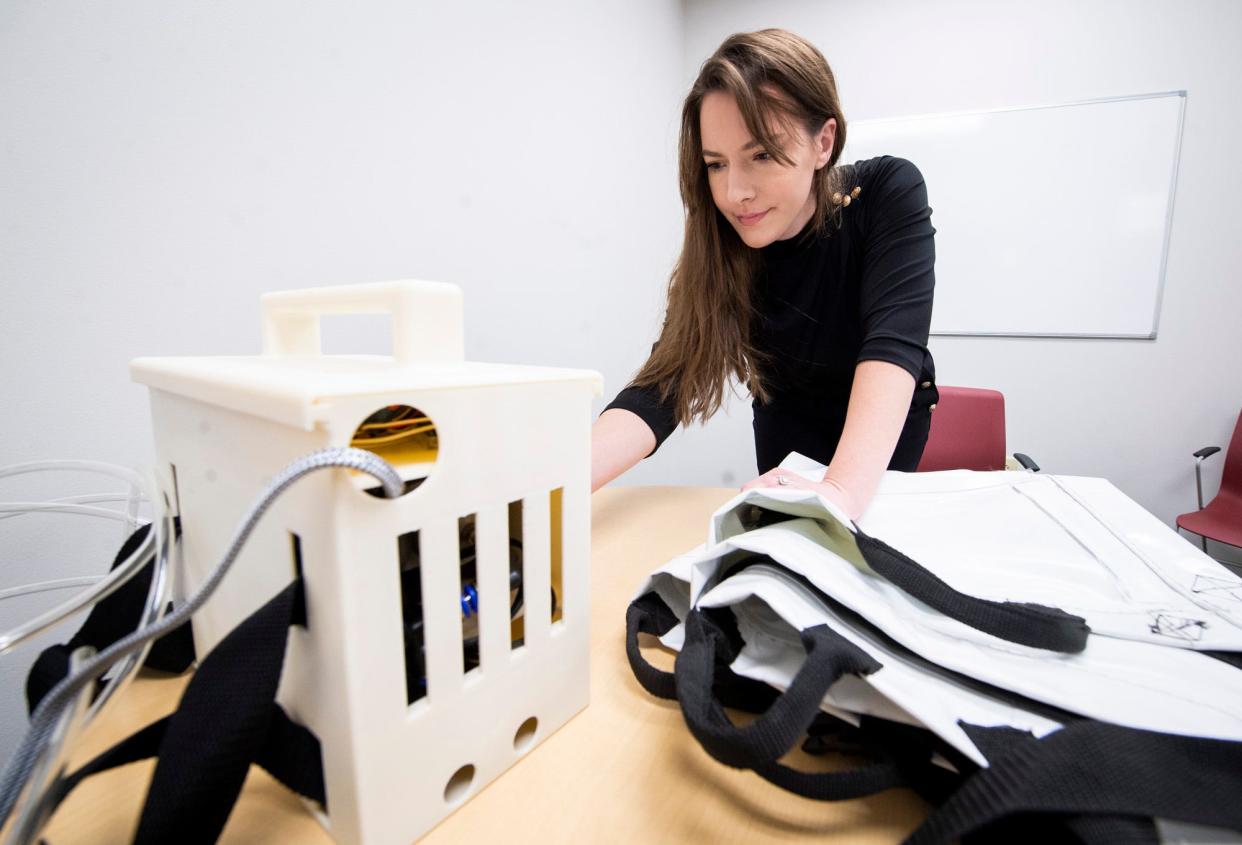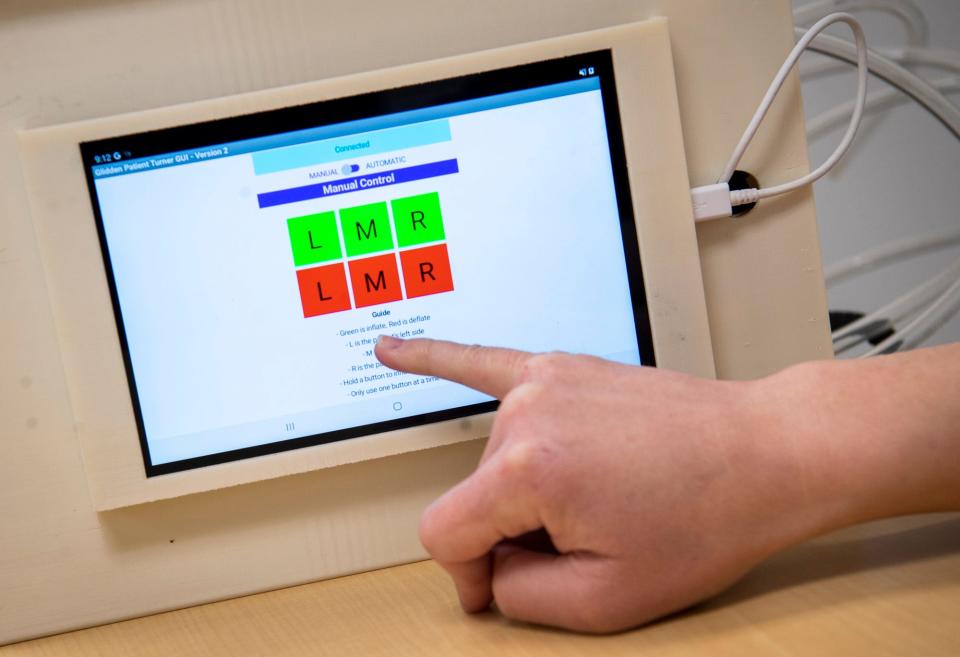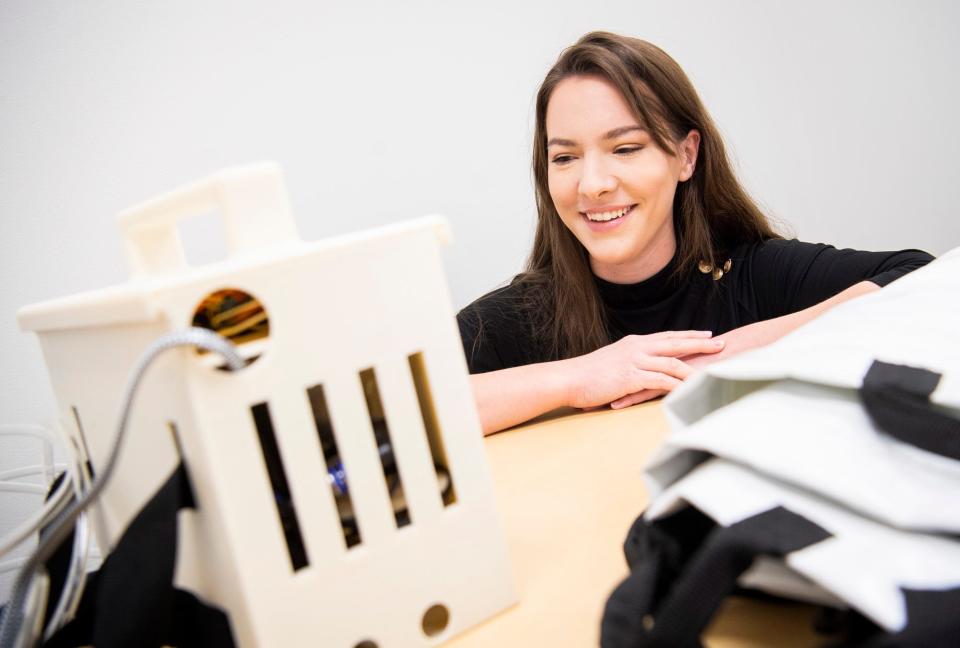This Indiana University bus driver has a device to revolutionize how hospital beds work

Morgan Miller doesn't like to do things conventionally. It's why the Martinsville native changed her double-major of psychology and business to one of general studies at Indiana University before she graduated. While she'd loved both the health field and business realm, the thought of being stuck within four walls all day, every day seemed smothering.
Now working as an Indiana University bus driver, her office space is a 35-by-45-foot metal box on wheels. But she hasn't given up her passion for health nor her entrepreneurial spirit. In her spare time, she blackens the pages of a notebook with ideas for new gadgets and tools.
Conventional rarely leads to exceptional. While Miller is anything but the former, her newly patented idea may very well be among the latter.
For the past few years, Miller has been tinkering with an idea for how to revolutionize care of bedridden patients. It's a device that will prevent injuries for both health professionals and patients.
"I really think that this would change healthcare," Miller said.

Device aids healthcare workers, mitigates risk of sores and ulcers for patients
The idea first sprouted in Miller's mind while she was working as a patient care tech at IU Health Bloomington in 2018. The job required providing support to other health professionals by administering basic care to patients, such as helping with daily tasks like getting them in and out of bed or checking vital signs. As Miller described it, patients outnumbered the technicians and the role easily became overwhelming.
"There were times where it was just one person, which is me, taking care of 20 people," Miller said.
One such daily task of a patient care technician involves "turning" a patient who can't easily move their body.
More doses, more death:More lethal and potent fentanyl means reversal drug naloxone is less effective
“If someone's bed-bound or if they've had surgery, to get blood moving through their body, you have to move them 90 degrees every two hours, so blood will flow. Otherwise, if you stay in one place for way too long, you start getting pressure sores and ulcers, (which) can actually become tunneling into your skin and can go to the bone. Obviously you don't want that," Miller said.
It's a physically demanding part of the job, lifting the patient to one side and propping their position up with several pillows. Two hours later, the technician must return to the patient's bedside and repeat the same exercise for the other side.
"It's a whole process and not everyone is a little, skinny granny. There are people who are 300 pounds and if you're by yourself, it's very strenuous," Miller recalled.

In a normal 12-hour shift, patients have to be turned over around six times.
"At the end of the day, your back, your neck, your shoulders were hurting so bad," Miller described.
Many of her fellow patient care technicians were older than she and faced some trouble with the physicality of their job. One former colleague, who was in her 60s, would frequently have to take time off work because she would get hurt turning a patient.
When Miller sustained an injury from turning, requiring her to take time off work and complete physical therapy, she began wondering how she could alleviate this problem. What if there was some sort of device that could automate the process?
She gave the internet a cursory look for such a device, coming up empty-handed. Later, she contacted a lawyer to do a patent search, and she learned there was no such device on the market.
My Favorite Ride:A 1998 Jeep Cherokee cements friendship between writers
She already knew she had an idea. Now, she saw an opportunity. After a few years of raising money and tinkering with prototypes, she had a product.
What she came up with is a mattress overlay where an air compressor system slowly turns the patient, up to weighing 300 pounds, to each side. The process can be done both manually or automated, with the health professional controlling the turn's duration through a touchscreen. Once it's programmed, the device will turn the patient to alternating sides automatically.
In addition to relieving a physically taxing part of the technician's job, this automated system can be helpful to patients. Patients will no longer have to be woken in the middle of the night for each manual turn. It also can be a relief for patients who are averse to physical touch.
Miller remembered one patient who refused to be turned, noting his discomfort with women seeing him in his hospital gown and touching him during the turning process. Because the staff was all female technicians, they were not able to routinely accommodate him.
"He ended up getting tunneling ulcers horribly," Miller remembered, adding the patient had to stay additional months in the hospital due to these injuries. "If I had this product underneath him, this wouldn't have happened."
After perfecting her device, Miller was granted a patent for the technology, which she is in the midst of licensing for hospital systems by engaging in some early conversations with regional healthcare partners. She hopes the device will be used in hospital beds across the country, helping both health providers and patients.
Celebrating how she's secured a patent, Miller will be part of a ceremony hosted in Evansville sometime next month, with final details still being ironed out for the particular time and place. As someone who grew up in Martinsville, Miller hopes this is just the first chapter in a local success story for innovating the healthcare landscape.
Reach reporter Rachel Smith at rksmith@heraldt.com.
This article originally appeared on The Herald-Times: Bus driver transforms hospital beds to combat patient ulcers, sores

